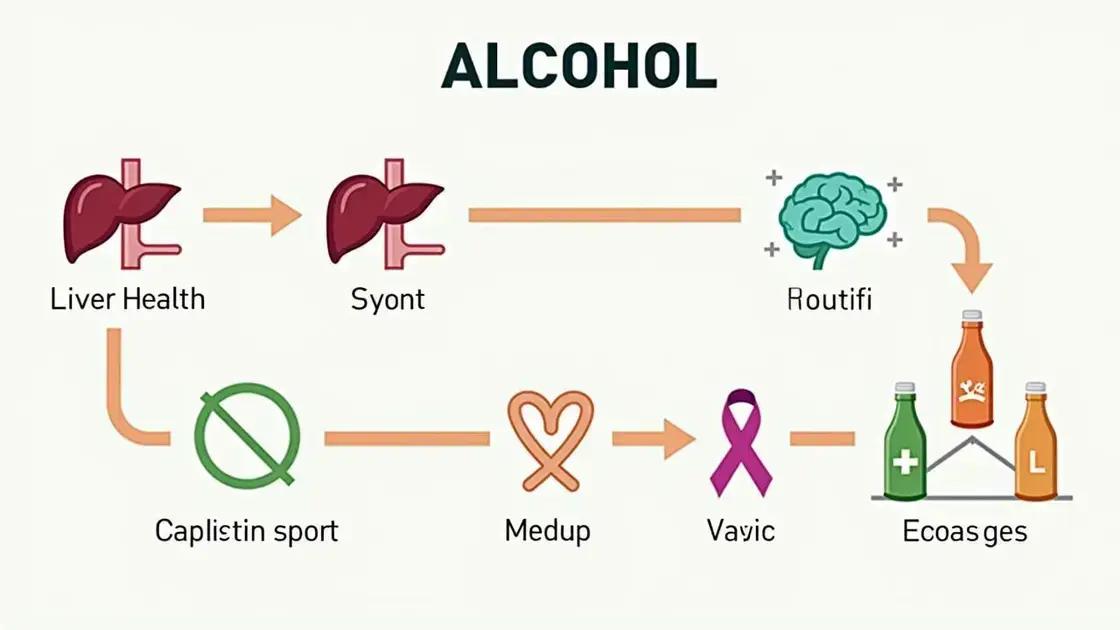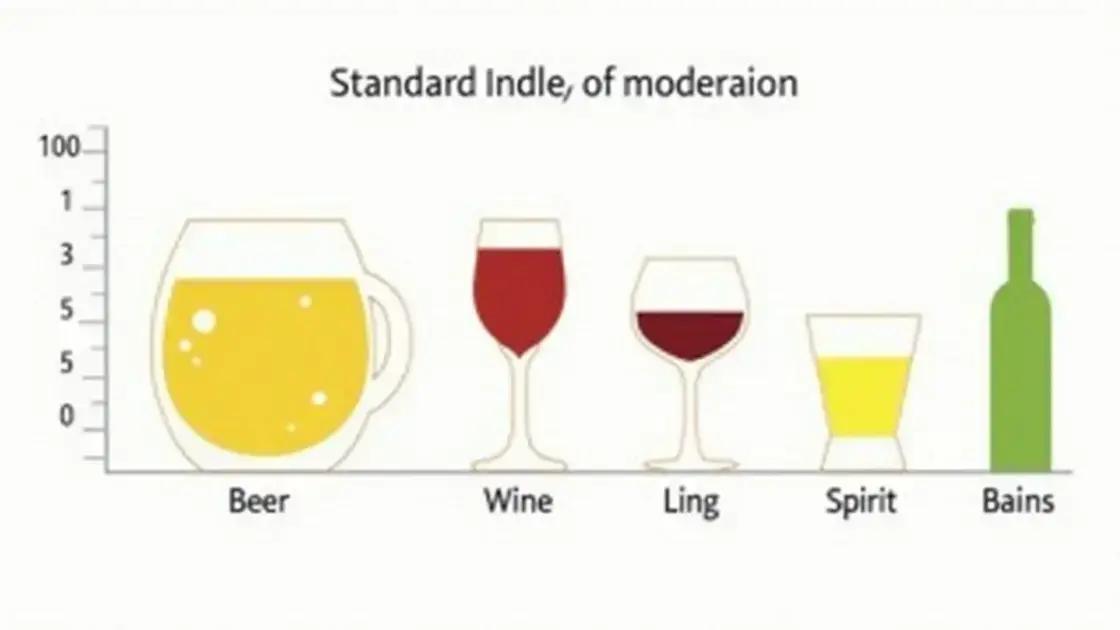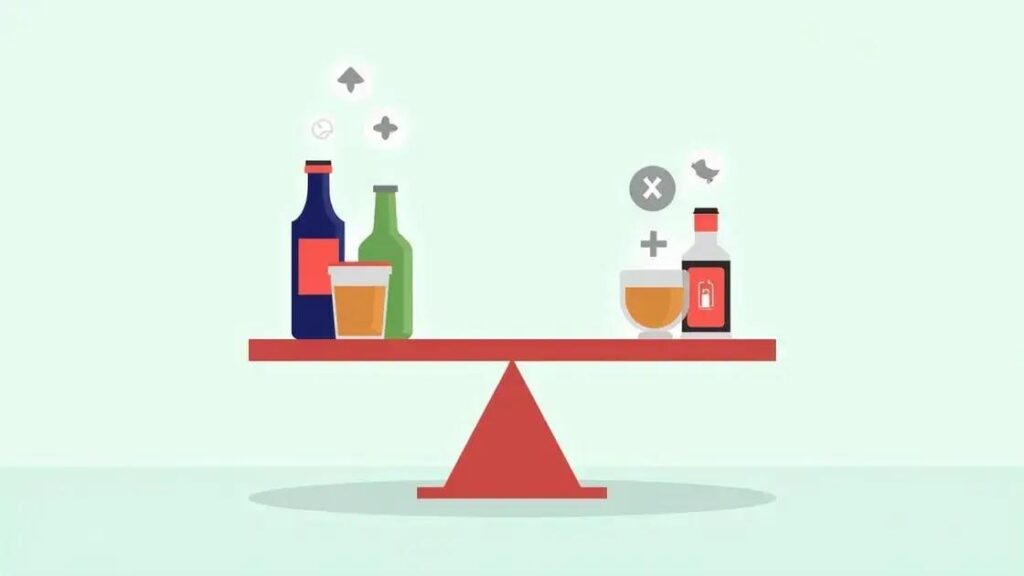The link between alcohol consumption and health risks is significant, with moderate drinking defined as up to one drink daily for women and two for men. Excessive consumption can lead to serious health issues such as liver disease, heart problems, and addiction. Making informed choices involves knowing your health status, understanding alcohol content, and being mindful of social influences to minimize risks.
The link between alcohol consumption and health risks is a vital topic we must explore. Many people aren’t aware of how drinking affects their overall well-being. With so much misinformation available, understanding the real implications of alcohol consumption can help you make informed choices. In this article, we will dive deep into what alcohol does to your body, the associated health risks, and tips for enjoying alcohol responsibly.
Understanding Alcohol Consumption

Understanding alcohol consumption is crucial for recognizing its effects on health. Alcohol is a common social drink, and many people enjoy it in moderation. However, it is important to understand what moderation means. For adults, moderate drinking is generally defined as up to one drink per day for women and up to two drinks per day for men.
Types of Alcoholic Beverages
Alcohol can be found in various forms, including beer, wine, and spirits. Each type differs in alcohol content. For example, beer typically has lower alcohol by volume (ABV) than spirits like whiskey or vodka. Knowing the difference aids in understanding consumption and its potential effects on health.
How Alcohol is Processed in the Body
When you drink, your body absorbs alcohol into the bloodstream. The liver processes most of the alcohol consumed. It can take about one hour for the body to process one standard drink. Drinking faster than this can lead to higher blood alcohol levels, increasing the risk of health issues.
Social Influences on Drinking
Social situations often influence how much and how often people drink. Peer pressure, cultural norms, and celebrations can all lead to increased consumption. Recognizing these influences is important for making informed choices about drinking.
Education about alcohol consumption, its definitions, and social impacts can help individuals make more responsible decisions regarding their drinking habits. By understanding alcohol consumption better, people can minimize health risks while enjoying social interactions.
Health Risks Associated with Drinking

Health risks associated with drinking alcohol can impact both physical and mental well-being. Consuming alcohol excessively can lead to serious health issues over time. Understanding these risks can help people make healthier choices about their drinking habits.
Physical Health Risks
One of the most significant risks of heavy drinking is liver disease, including fatty liver, hepatitis, and cirrhosis. The liver is crucial for breaking down toxins, and when overloaded with alcohol, it struggles to function properly. Additionally, excessive drinking can lead to heart problems, such as high blood pressure, irregular heartbeat, and an increased risk of stroke.
Impact on Mental Health
Drinking alcohol can also affect mental health. Many people experience mood changes, increased anxiety, and depression as a result of heavy drinking. Alcohol can alter brain chemistry, leading to dependence and addiction over time. Moreover, alcohol consumption is often linked to increased instances of risky behaviors.
Cancer Risk
Research shows that alcohol consumption increases the risk of certain types of cancer, including mouth, throat, esophagus, liver, breast, and colorectal cancer. The more you drink, the higher your risk, making it important to be aware of how alcohol affects your health.
Social and Economic Impact
The health risks extend beyond the individual. Families and communities can feel the effects of alcohol-related health issues, including increased medical expenses and loss of productivity. Understanding these risks encourages responsible drinking and fosters healthier communities.
How Much is Too Much?

How much is too much? It’s essential to know the limits of alcohol consumption to stay healthy. The guidelines suggest that moderate drinking is up to one drink per day for women and up to two drinks per day for men. But what exactly does this mean in real terms?
Defining a Standard Drink
A standard drink in the United States typically contains about 14 grams of pure alcohol. This can be found in:
- 12 ounces of beer (about 5% ABV)
- 5 ounces of wine (about 12% ABV)
- 1.5 ounces of distilled spirits (about 40% ABV)
Understanding these definitions is key to tracking how much alcohol you consume.
Signs of Excessive Drinking
Recognizing when you may be drinking too much is vital. Some signs include:
- Frequent hangovers
- Drinking every day or almost every day
- Feeling guilty about drinking
If you notice these signs, it might be time to evaluate your drinking habits.
Health Risks and Drinking Limits
Drinking above moderate levels not only increases health risks but can lead to dependency and addiction. Health professionals recommend not exceeding the defined moderate levels. Consistently drinking more than these limits can lead to serious medical conditions.
Making Smart Choices
Making informed choices about drinking is important. Understand your limits and learn to enjoy alcohol without overindulging. If you find it difficult to cut back, consider seeking help from a healthcare professional.
Making Informed Choices about Alcohol

Making informed choices about alcohol is essential for maintaining good health. Understanding your own body and tolerance levels can guide you in making better decisions. Here are some key factors to consider when evaluating your alcohol consumption.
Know Your Health Status
Before drinking, it’s important to assess your health. Consider any medical conditions you have or medications you take. Some health conditions and medications can have harmful interactions with alcohol. Consulting with a healthcare provider can give clear guidelines tailored to your situation.
Set Personal Limits
Establishing personal limits for drinking can help you stay within a healthy range. Decide how many drinks you will have before attending social events. This approach encourages mindfulness while drinking and helps you to avoid overindulgence.
Choose Wisely
When selecting alcoholic beverages, be mindful of what you choose to drink. Some drinks have higher alcohol content than others. For instance, cocktails can often contain multiple standard drinks in one serving. Opting for lower-alcohol options can help you maintain control over your intake.
Be Aware of Social Influences
Social environments can pressure people into drinking more than they want. It is essential to recognize these pressures and find strategies to resist them. You can opt for non-alcoholic beverages or set a predetermined number of drinks to keep your consumption in check.
By understanding your health, setting limits, and being mindful of your choices, you can make informed decisions about alcohol that promote a healthier lifestyle.
In Summary: Understanding Alcohol and Making Safe Choices
Understanding the link between alcohol consumption and health risks is essential for everyone. By learning about what constitutes moderate drinking, recognizing health risks, and how much is too much, individuals can empower themselves to make informed decisions.
Making informed choices about alcohol not only benefits personal health but also positively impacts family and community. It’s important to know your limits, choose wisely, and be aware of social influences that may pressure you to drink more than you should.
Ultimately, knowledge is key. By being informed and responsible, you can enjoy alcohol safely while minimizing health risks and enjoying a healthier lifestyle.
FAQ – Frequently Asked Questions about Alcohol Consumption and Health Risks
What is considered moderate drinking?
Moderate drinking is defined as up to one drink per day for women and up to two drinks per day for men.
What are the health risks of excessive alcohol consumption?
Excessive alcohol consumption can lead to liver disease, heart problems, increased cancer risk, and mental health issues such as anxiety and depression.
How can I know if I am drinking too much?
Signs of excessive drinking may include frequent hangovers, feelings of guilt about drinking, and continual drinking despite knowing its negative effects.
What should I consider before drinking alcohol?
It’s important to assess your health status, medications, and any conditions that may interact negatively with alcohol.
How can I make informed choices about alcohol?
You can make informed choices by understanding your limits, being aware of alcohol content in drinks, and recognizing social pressures that may influence your drinking.
What strategies can help reduce alcohol consumption?
Setting personal limits, choosing lower-alcohol beverages, and having non-alcoholic options available can help you reduce consumption.












